The Kammok Firebelly Trail Quilt is a 30*F rectangular quilt that can be used as a comforter, a top quilt, or a full-length hammock underquilt. While it’s optimized for use with Kammok’s hammocks, it’s general-purpose enough it can be used with hammocks from other manufacturers or solely for ground use on top of a sleeping pad.
Specs at a Glance
- Style: Convertible: comforter, top quilt, and underquilt
- Temperature Rating: 30*F / -1oC
- Total Weight: 25 oz / 708 g (27.3 oz actual)
- Optional Accessories:
- Stuff sack: 1.1 oz
- Sleeping pad attachment straps: 0.7 oz
- Underquilt extension kit for use on large hammocks: 0.5 oz
- Open Dimensions: 88 in × 54 in / 224 cm × 138 cm
- Packed Dimensions: 12 in × 7 in / 30.5 cm × 17.8 cm
- Shell/ Lining: 15 denier cire ripstop nylon w/ DWR waterproofing, branded Atmos XTM
- Insulation: RSD DowntekTM water repellent 750 fill power down
Trail Quilt Design
Opened up, the Firebelly is an 88” x 54” rectangle with elastic drawcords at both of the shorter edges, and five 3-inch-long strips of grosgrain ribbon with integrated snaps along each of the two long edges (10 in total). The grosgrain and snaps can be tucked away into little pockets when not in use, so you don’t feel them, and serve a variety of purposes for the various configurations of the quilt. Snap a few together to create a footbox, snap it all the way up for more coverage, snap the top end to create a seal at the neck, or snap all of them to a Kammok hammock to serve as an underquilt (explained below).
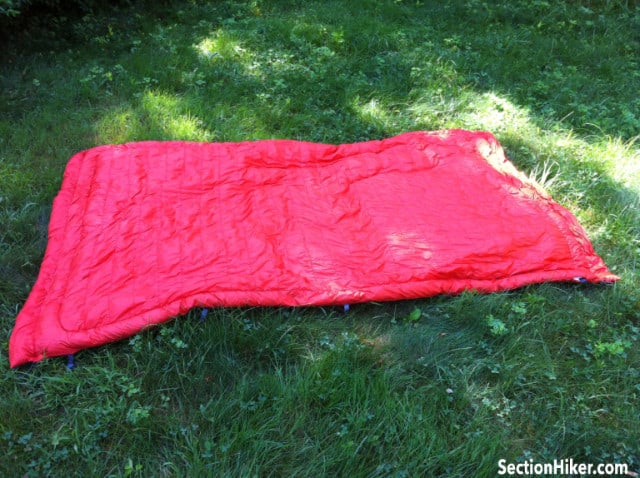
The Firebelly is insulated with 750 fill power Downtek water-resistant down, which has been certified as responsibly sourced, meaning the birds from which the down comes have not been subjected to unnecessary harm, like force-feeding or live-plucking. This is a standard that more and more higher-end gear companies are adopting.
The quilt is baffled, not sewn-thru, using a design called Insotect baffling (used in many sleeping bags), a honeycomb-shaped structure that allows you to move the down throughout the quilt via shaking to distribute the warmth to where you need it. While sewn-thru designs can have cold spots where the two layers of fabric come together at the stitching points with no down between them, baffled construction keeps the two layers of fabric evenly spaced to the height of the internal baffles throughout the quilt and is warmer.
Kammok Firebelly Trail Quilt
Warmth
Weight
Comfort
Features
Versatility
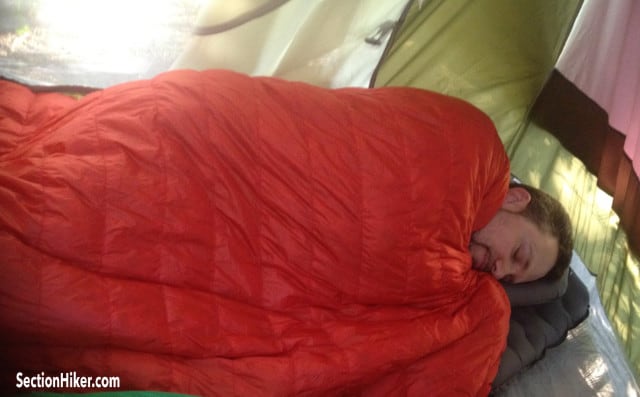
Use as a comforter
In its simplest mode, with none of the snaps connected and the drawstrings kept loose, the Firebelly can be used as a comforter just like what you’d have on your bed at home. This is good for nights that are much warmer than the quilt’s temperature rating because you can easily dump heat by kicking a foot or two out from under the quilt, or by pulling the quilt partially off yourself. It’s also nice for in-camp use to wrap around your shoulders or legs while you’re cooking or hanging out in the evening or early morning.

Use as a top quilt
To use the Firebelly as a top quilt, match up some of the snaps at one end, and then cinch the drawcord on that same end. A small baffle is created when you cinch the drawcord, and this can be stuffed in the hole at the foot end to seal off air gaps. You can also connect the snaps at the neck end and pull that drawcord, again creating a small baffle, to seal the quilt around your neck and shoulders. To minimize drafts, you can snap together more of the snaps along the middle like a cocoon, or you can snap two pairs of the quilt’s snaps to the two included elastic pad straps to attach the quilt to a sleeping pad.
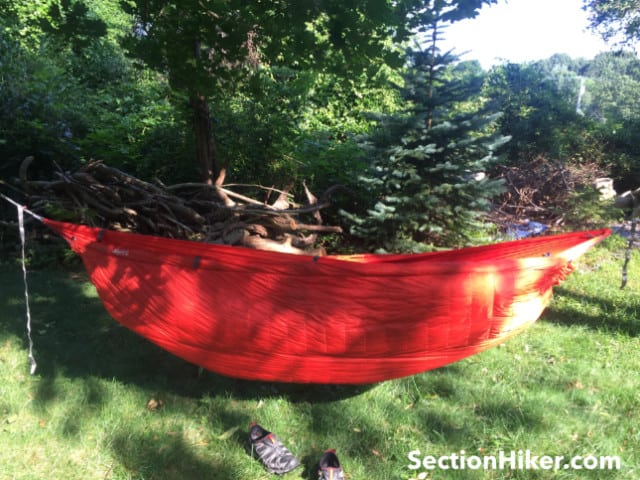
Use as an underquilt
Because of convective cooling in a hammock, you need to use insulation on the underside in anything but hot weather. Some companies offer hammocks with integrated (sewn-on) insulation to reduce fiddle factor and drafts common with underquilts, but the versatility of the hammock is limited to whatever the integrated insulation range is. Stand-alone underquilts are much more common and highly adjustable but have a learning curve to effectively use them without experiencing drafts.
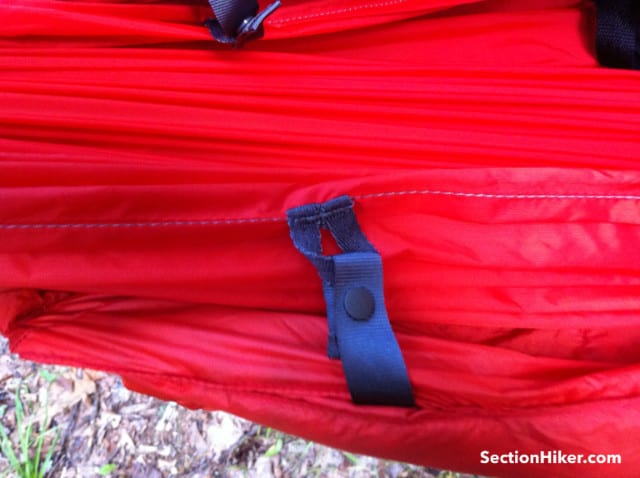
Kammok’s Firebelly is almost a hybrid between these two options because the quilt can snap on to the gear loops found on Kammok’s hammocks to stay in place along the full length of the hammock, but it can be easily removed as well. To use the Firebelly in underquilt mode, pull the drawstrings tight at both ends and clip these drawcords into your hammock’s carabiner or other suspension connection. For the Roo UL, the Roo Single, and other smaller hammocks, the drawstrings alone are long enough to clip in; on bigger/longer hammocks like the Kammok Roo Double, you may have to use the included underquilt attachment kit which are elastic cords that clip on to and extend the reach of the drawcords. Finally, thread the grosgrain strips on the Firebelly through the gear loops on the sides of the hammock and snap them closed around the loops.
Using the Firebelly as an underquilt with a non-Kammok hammock is easy, but you lose that seamless integration with the hammock as it operates more like a standard underquilt: just run a long length of elastic cord through the Firebelly’s snap-loops, add a cordlock to keep the two ends together and put the loop ends over your hammock’s gathered ends, adjusting the fit with the cordlock and sliding the Kammock into place along the length of the elastic cord. If you want to recreate the underquilt/hammock integration with a non-Kammok hammock, you could sew on your own grosgrain attachment loops to your hammock to match the positions of the snaps on the Firebelly.
As described in the top quilt mode, the drawcords create small baffles when pulled tightly. While I’ve been using the quilt over the summer and haven’t gotten it out in cold temperatures, these baffles, tucked into either end in underquilt mode can serve as draft collars.
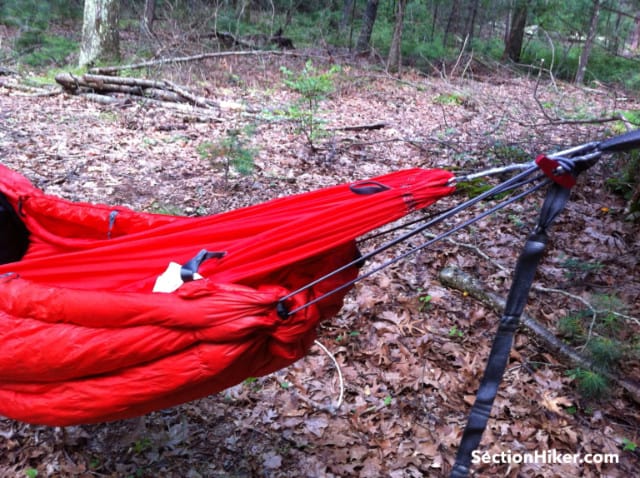
Because the Firebelly is sized to fit Kammok’s entire range of hammocks, it is quite big on the Roo Single UL. The snaps are 1.5 inches away from the quilt body on the webbing pieces, and there is no way to cinch up the webbing tightly after snapping it to the hammock, so there is some play (looseness) between the hammock and the quilt, but this usually doesn’t result in the quilt falling away from the sides of the hammock–on the contrary, once I got in the hammock, the Firebelly actually came up higher on the sides than the hammock did. Initially, I felt that the bottom of the underquilt sagged away from the hammock creating a gap, but after watching Kammok’s video series, I learned that slightly loosening the drawcords at each end pulls the Firebelly higher and tighter, and that worked for me.
Recommendation
I’ve used the Firebelly Trail Quilt overnight on the ground and in a hammock, as a comforter, an underquilt and a top quilt, frequently, during humid nights with rainstorms, and it performed admirably in each iteration. At a personally-measured 27.3 ounces, the Firebelly is not the lightest option, especially for a 3 season underquilt, but the ability to use it in multiple configurations, thereby reducing the number of distinct pieces of gear one needs, and its extensive coverage, may make the weight penalty worth it to many users.
Compare 4 Prices
-

 Kammok$224.95View
Kammok$224.95View -

 Amazon US$289.95View
Amazon US$289.95ViewAmazon.com Price: $289.95 (as of 04/24/2024 14:37 GMT-0400) Details
Product prices and availability are accurate as of the date/time indicated and are subject to change. Any price and availability information displayed on Amazon.com at the time of purchase will apply to the purchase of this product.
-
 REI$299.95View
REI$299.95View -
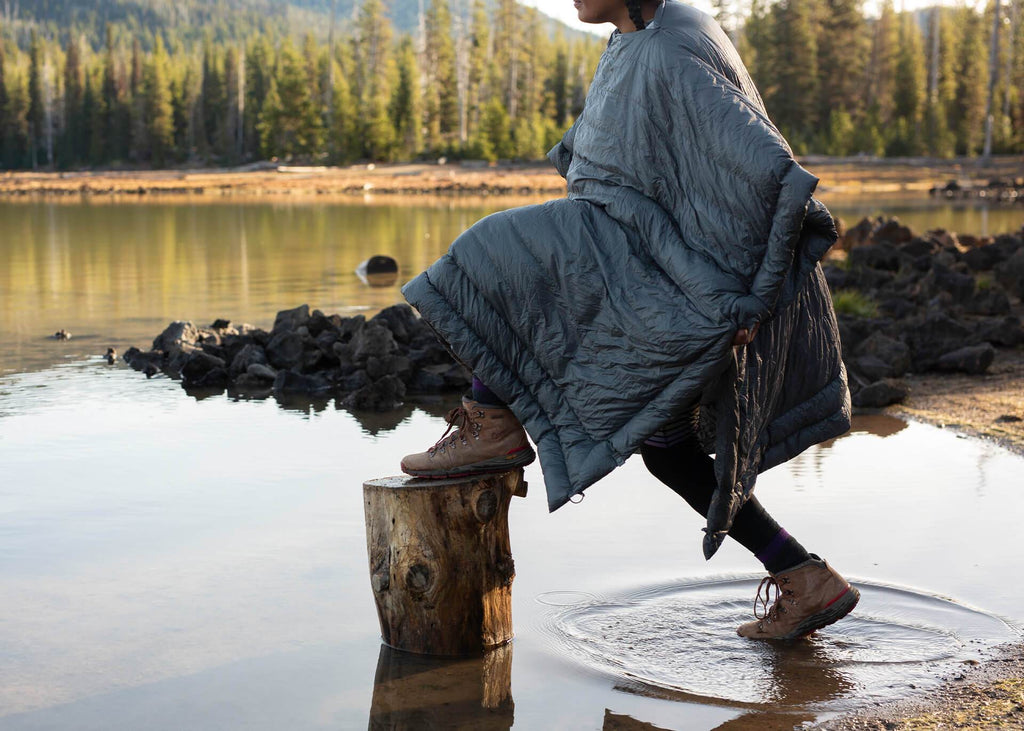
 Kammok$299.95View
Kammok$299.95View
Disclosure: Kammok provided the author with a Firebelly for this review.
SectionHiker is reader-supported. We only make money if you purchase a product through our affiliate links. Help us continue to test and write unsponsored and independent gear reviews, beginner FAQs, and free hiking guides. SectionHiker.com Backpacking Gear Reviews and FAQs
SectionHiker.com Backpacking Gear Reviews and FAQs 

Nice review. Terrapin Outfitters Cocoon, which I have, is also an option doing the same for warmer weather.
I have to ask though. Since one would still need a top quilt and an underquilt, how does this save on the number of pieces of gear one has. A good number of top quilts, not all, also unwrap, unbutton, or unzip, allowing one to also use it as a throw or comforter.
No mention of this in article, but firebelly can also be used as insulating poncho (head hole in middle). So this could replace or augment wearing a puffy for passive insulation when you’re hanging out at camp on cold mornings/nights. I haven’t seen that on other quilts.
The version we reviewed didn’t have a head hole. Per Kammok’s website, “Our newest version adapts to any environment as a hands-free poncho”
Hi Jerry, thanks for the comment and question. The way I wrote it wasn’t too clear, so I appreciate the opportunity to clarify. Here’s my reasoning: While it’s true that a hammocker needs both a top quilt and underquilt, and the Firebelly has to be used for one or the other, a standard underquilt is a single–use item–it can’t be used as a top quilt. Since the Firebelly can, it can be used on non-hammocking trips as well (when a standard underquilt would be left at home), for example, as a second top quilt when tenting with family members, or stacking it with your topquilt (on the ground) to expand the usage into colder temperatures.
Better explanation.
And as I said above, I have a Terrapin Outfitters Cocoon which is the same except not rated as cold.
Jerry, is the Cocoon the same as what they’re now calling the Modular Shell? I don’t see the Cocoon on their site. I like how their footbox snaps overlap the insulation to create a baffle to seal the gaps, as well as that “Scotty Mod” attachment to the ridgeline to keep the topquilt from falling out of the hammock when you have to get up in the night.
Could you double-up two of the Firebellies as underquilts hung together on a Kammok hammock to push down into colder weather?
Probably. The danger would be a big air gap between the firebellies that lost its heat. I think you’d be better off just getting an underquilt with the right temp rating and a winter sock. If you’re just camping and not hiking in snow, you could have it made with Climashield and not down and bring the cost way down.
Thanks. I’m hoping to avoid spending too much more money, but I guess I should have expected that changing from a tent to a hammock would get expensive in cold weather. I was thinking I could use one Firebelly as an underquilt and another as a top quilt in moderate weather, but use both Firebellies underneath with a warmer quilt I already own on top in cold weather. I’ve bought a Hammock Gear sock, but haven’t tested it in the mountains yet.
I did this last winter–hung the Firebelly and then another company’s 30*F quilt under it, and a full wind sock over everything. I was cozy at 0*F and ended up sleeping late, despite telling my sleeping buddy I was an early riser.
Um, that should have said hiking buddy! Maybe because it’s 4am I only have sleep on the mind!
Just to be clear, everyone’s cold tolerance is different. Definitely experiment at home first to see what temps you’re comfortable at when stacking quilts.